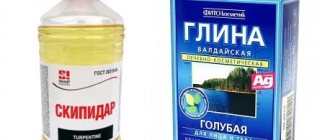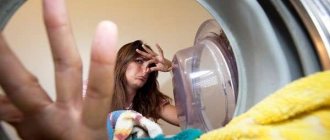Washing machine smell is a fairly common problem. Water constantly passes through the unit, some of it remains inside the tank, in tubes and hoses. Humidity and heat are favorable conditions for the growth of bacteria and fungus, and with them an unpleasant odor appears.
An unpleasant odor can appear in any washing machine, even a recently purchased one.
How to remove odor from an automatic washing machine and prevent its reappearance? In our article we will give answers to these questions. Let's start by looking at the causes and sources of the appearance of a repulsive odor.
Why and how does odor occur in the washing machine?
Many people are interested in how to clean an automatic washing machine from smells? Why does the washing machine start to smell rotten and rotten if we do everything the same, use the same powder and don’t change anything? How to get rid of an unpleasant odor? It is important to understand the reasons. It turns out that when caring for the washing machine, we often make traditional mistakes that lead to the appearance of an unpleasant odor. The causes of unpleasant odor from an automatic washing machine are staphylococci, molds and E. coli. A rotten smell appears when entire colonies of bacteria form in the unit. In order for them to reproduce, they require moisture and warmth. The washing machine is the ideal place for this. Housewives do a lot of things wrong:
- Close the door. If you leave the loading hatch closed after finishing the wash, bacteria will begin to form inside, as an ideal environment will be created for their development.
- We strive to save energy. When we wash at low temperatures, microorganisms are not destroyed. Requires heating to 90 degrees. Favorite washing modes at 30 or 40 degrees become favorable for the development of entire colonies.
- We use low quality powder. The same can be said about the rinse aid. If the product is bad, it does not dissolve completely in water. Particles remain on the filters, drum and other parts of the machine. Such plaque is an ideal environment for the development of bacteria.
- We do not follow the dosages indicated on the packages. Manufacturers specifically prescribe the required amounts of detergents. Using more quantity does not guarantee quality. Excess remains on all elements, powder tray, filters, hoses and other parts of the unit. They are also not rinsed completely, so the laundry turns an unsightly gray color.
- We don't check the pockets. Leftover food, crumbs, candy and pieces of paper, as well as other debris, become soaked and settle on the hoses and filters.
- Wash with too hard water. The water contains salts and particles of organic origin, which are deposited on the heating element. Gradually, the carbon begins to break off and form a sediment. This becomes a favorable environment for the development of entire colonies of harmful microorganisms.
- We install the washing machine unevenly. If the device is tilted, the water does not drain completely into the sewer. Partially it remains and begins to rot.
- We do not regularly clean the filter. During the draining process, hair and large debris remain on the filter. They then decompose and lead to a foul odor.
- We do not rinse the bath, which is intended for detergents. A slimy coating appears, which favors the development of mold and other abominations.
- After completing the wash, do not wipe the drum. There is water left in it. Gradually it begins to fade and stink.
- Do not wash the rubber cuff that is provided on the loading hatch. This is how a lot of garbage accumulates.
- We store dirty laundry in the drum. Bacteria begin to multiply and produce an unpleasant odor.
- We do not trust installation to experienced specialists. It is likely that the drain hose is not connected correctly to the sewer. The drain hole should be located at a maximum height of 50 cm from the floor. The hose is fastened in the shape of the letter U. Otherwise, an unpleasant odor will appear.
Removing the smell from the washing machine will be a priority task that will have to be resolved quickly. If you find out the reason, you can quickly eliminate this problem.
Tips for using a washing machine. Preventive measures against unpleasant odor
The best way to solve a problem is to prevent it from happening. Therefore, if you do not want to find ways to eliminate the unpleasant odor from the machine and experiment with different folk recipes, operate the equipment correctly and carry out regular preventive maintenance.
After each use of the equipment for its intended purpose, wipe the inside of the device with a dry, clean cloth, wash the powder containers and rubber elements, ventilate the machine, leaving the hatch for loading laundry open for 3-4 hours.
Periodically clean the filter element and heating element of the device. Do not store dirty clothes inside the machine and shake things before loading them into the drum, check pockets for debris and crumbs. It is better to thoroughly rinse heavily soiled items with stains of gasoline, kerosene and other caustic substances in clean water before washing them in the machine.
Special products for getting rid of odors in the machine
If there is a sewer smell coming from your washing machine, you can use special preparations to effectively eliminate the nasty aroma. Most often we trust advertising in choosing this or that product, but here we should be very careful. Here are our recommendations:
- Calgon is a highly advertised product, but it is absolutely not effective.
- Antiscale is a good, proven product available from many manufacturers. Among the minuses, it is worth noting the possible clogging of the drain hose from cleared scale.
- Special cleaners, such as Dr. Beckmann - very good, according to reviews, for getting rid of scale and dirt.
Before using the drugs, it is important to carefully study the attached instructions. Do not use multiple cleaners at the same time. Work must be performed wearing a respirator and gloves.
Drying
The drying mode is not available in all models . This is an additional option that allows you to process things by drying them. After such exposure, the laundry comes out of the machine almost dry.
In machines without drying, things remain damp even with very intense spinning. The presence of a drying mode in the device significantly increases the cost of the washing machine.
Read this article for tips on how to dry your laundry.
Dishwasher tablets
Another good way is dishwasher tablets. Cleaning your washing machine from smells will be a real pleasure. Today, products have been developed that easily remove plaque and grease from dishes, help disinfect and eliminate unpleasant odors. They can easily cope with identical problems in the washing machine. You need to take five tablets and put them in the drum. After this, the wash starts at high temperature. Next, do the rinsing. It is important to thoroughly wipe all accessible parts dry. This method is suitable when the pollution is not so strong. You can also carry out monthly prevention with home remedies.
Preventive measures
Of course, it is very difficult to deal with several layers of scale and deposits with a strong odor. The best thing to do is to take care of your washing machine on a regular basis, not when it starts to get sick. Try to follow these rules to keep your equipment in good working order longer:
- Do not lock the door immediately after washing; let the machine remain open for 1-2 days. The parts need to dry.
- Do not store dirty clothes in the washing machine. Buy a laundry basket that will allow air flow.
- After washing, check the drum for small debris and wipe the rubber cuff with a dry cloth. Otherwise, it will have to be changed, since the accumulated plaque can eat into the rubber.
- Try not to use untested cheap products.
- Pour a sufficient amount of powder into the tray, without exceeding the measure.
- Invite a specialist periodically. He will examine your car inside and out.
- Be sure to check that your washing machine is level and in accordance with the recommendations. When skewed, some of the water may accumulate without finding a way out.
- After each wash, wipe the drum with a dry cloth.
- Check pockets of clothes before loading them into the machine.
Vinegar
If you don’t know how to remove the smell from your washing machine, know that you can use home remedies if you wish. Regular vinegar is especially often used, which effectively eliminates unpleasant odors. Now it's so easy to clean your washing machine from musty smells. It will be possible to dissolve lime deposits on the heating elements. In combination with hot water, the composition can easily cope with mold and bacteria. Cleaning with vinegar is allowed once every six months. Acid can damage machine parts made of rubber.
Eliminating odor in an automatic washing machine begins by taking a glass of acid and pouring it into the powder tray. After this, the mode is set in which the laundry is usually boiled. The temperature should be 90 degrees. When the main wash stage is completed, you need to pause. The unit is left in this state for a couple of hours. Then the machine is started again in rinse mode. You must wait until the program completes. It is necessary to unscrew the pump filter to drain. There may remain pieces of soot that have broken off. Finally, an additional rinse is started. Vinegar is also used instead of rinse aid. Three tablespoons of acetic acid are poured into the compartment intended for rinsing. This will prevent the smell of rot. If you use apple cider vinegar, your laundry will have a pleasant aroma.
Bookmark norms
The maximum permissible volume of items specified by the equipment manufacturer is determined by their dry weight. But it should be borne in mind that some products are light in weight but large in volume, while others, on the contrary, are heavy but compact.
Bulky items such as jackets or pillows should be washed one at a time. This will improve the quality of processing and will not create additional stress on the mechanisms of the device.
The best option for storing laundry is to leave some space on top of the clothes in the drum. This approach will allow you to remove dirt more efficiently and rinse the detergent thoroughly.
When loading the drum, it is recommended to adhere to the following standards:
- For synthetics, it is enough to put things in ½ volume.
- For delicate products – by 1/3.
- For linen and cotton, it is possible to fill almost the entire volume, but it would be better to fill it to ¾.
In cases where the batch of items for washing has not yet been assembled, sometimes it is tempting to throw just one small item into the drum, for example, a T-shirt. At the same time, during the washing and spinning process, the work may freeze due to the inability of the washing machine to evenly distribute the laundry.
Is it possible to wash one item? If only one thing needs washing, then it is better to find a “company” to load it into the automatic machine. This could even be a clean towel, for example.
Lemon acid
Citric acid will help remove odors from your washing machine. Cleaning your car with citric acid is allowed every four months. 100 g of acid must be poured into the powder tray. After this, select a program that guarantees maximum water heating. After this, an additional rinse is required. Finally, the cuff and drum should be thoroughly wiped. We leave the door open. If washing is performed frequently, it is possible to carry out this procedure for prevention every month or two. But in this case you need to take a maximum of two tablespoons of acid.
Breakage prevention
It is easier to prevent a malfunction than to repair it later. It is recommended to follow the installation rules described in the instructions. Some users artificially lengthen the drain hose, thereby increasing the load on the pump.
Before washing, things need not only to be sorted, but also to remove foreign objects from pockets. Clothes with sequins and beads are washed inside out only, or placed in a special bag.
The drain filter is periodically checked for blockages.
Follow these simple recommendations and your washing machine will last much longer.
Baking soda
Another option to remove unpleasant odors from your washing machine is baking soda. This will get rid of mold inside the unit. You will also be able to forget about fungal plaque. You don't have to think about why your washing machine smells bad. You just need to take a glass of water and a glass of soda. The solution is applied to all affected parts. Another glass of sodium bicarbonate is poured instead of powder. After this, boiling is started, as well as additional rinsing. Copper sulfate can be a substitute for meat. To do this, take a liter of water and dilute 30 g of vitriol in it. Available parts are processed, and the remainder is poured into the drum. After this, the wash is started, at which the water heats up to 90 degrees.
What to do if water is constantly pouring into the drum
The situation is different from previous cases when water collects in the drum of a turned off washing machine. Reasons for this malfunction:
- The fill valve is broken.
- There is a blockage in the sewer.
- Incorrect hose connection.
Since water is constantly pouring in, the machine passes it through the hatch cuff. This means the fill valve is faulty. The reason may lie in its membrane or electronics.
- The electronic board sends a signal to the fill valve when to draw water and when to stop drawing. When filling, the valve membrane opens and flow enters the tank. To stop dialing, the membrane closes. If the valve's wiring is faulty, it will not receive a signal to tell it when to stop drawing water.
- Over time, the valve membrane could become damaged. As a result, water is constantly drawn into the tank.
How to check if the valve is faulty? Turn on the water supply valve. If the drum remains dry, then the problem is in the valve. The part cannot be repaired, but you can replace it yourself:
- Remove the top cover of the machine - the valve is located at the back wall.
- Disconnect the wiring connectors.
- Remove the screw on the back that holds the valve in place.
- Disconnect the hoses leading to it.
- Install the new part.
If dirty, waste water appears in the drum, the reason is a clogged sewer or an incorrect connection.
Incorrect connection of the hoses leads to wastewater flowing through the hose into the washer tank. And if there is a blockage in the sewer, then water from the siphon elbow is poured into the tank.
To solve the problem, you need to clean the sewer and properly connect the system to the water supply.
Chlorine-containing products
Chlorine will help remove odors from your washing machine. Using chlorine-containing compounds is very convenient to get rid of unpleasant odors. At the same time, they additionally disinfect. You can take any chlorine-based product. An example is whiteness. You should take 100 g and pour it into the compartment intended for powder. After this, the boiling program starts. An additional rinse is required. The drum and cuff are wiped after use so that the chlorine does not “eat” the rubber. The door is not closed. It is necessary to ventilate the room well after cleaning. You can also wash your washing machine to remove the rotten smell.
Signs and causes of the problem
Please note when you find that there is water left in the washer:
- After the wash cycle, while removing laundry from the drum. Things didn't work out well.
- When the car froze, a fault code appeared on the display. In this case, the hatch door does not open.
Why do such breakdowns occur? There may be the following reasons:
- The drain hose is kinked or there is a blockage in the drain system.
- The drain pump is broken.
- The pressure switch (pressure switch) is faulty.
- The electronic board is faulty.
How to prevent odor in your washing machine
Many people worry that if their washing machine smells rotten, what should they do? It is worth trying to avoid problems rather than solve them. If you don’t want to constantly think about why your washing machine smells like rotten water, you should follow these simple recommendations:
- To avoid smell from the washing machine during washing, do not leave laundry in the unit: washed or dirty.
- The unit must be thoroughly ventilated after each wash. Otherwise, there will be a damp smell in the washing machine.
- Preventive measures should be carried out regularly to eliminate scale and fungus. For example, you can wash your washing machine to remove odors.
- If you need to wash things that are stained with gasoline and other caustic substances, you should first rinse the clothes and only then wash them. Otherwise, you will have to wonder why your washing machine smells rotten. It is important to purchase high-quality powders and gels. You should not buy goods of dubious quality.
- It is good to wash things at high temperatures. With regular cold washing, mildew will inevitably appear and a musty smell will appear in the washing machine.
- If problems are noticed in the operation of the unit, you should immediately contact professionals with solid experience. The technician will be able to find out why the smell appeared from the washing machine drum. He will quickly solve this problem.
Now you know how to get rid of the smell in your washing machine. If you follow certain rules and regularly clean your machine, you can significantly extend its service life. If there is an unpleasant odor in your washing machine, act quickly. Write about what tools helped you in the comments!
Traditional methods
To clean your automatic machine from dirt and odors, you will need a minimum of time, effort and money. In addition, these methods are time-tested.
Hot water
The easiest way to clean it is to run the wash cycle at high temperatures (at least 90°C) for a three-hour cycle. This treatment will help kill all microorganisms that have settled inside.
Vinegar
Vinegar easily eats away the limescale that accumulates on the electric heater, as well as the deposits inside the drain hose. Moreover, despite its aggressiveness, the acid does not in any way affect the further operation of the washing machine. It also neutralizes strong odors and disinfects.
Attention! Vinegar should be used as carefully as possible when cleaning rubber and silicone parts. And no more than once every four months.
How to clean a washing machine with vinegar:
- Pour 2 tbsp into the tray. 9% vinegar. Set the wash cycle to 90°C for three hours. Start the machine, turn it off after 5 minutes and leave it for an hour. During this time, the acid will have time to dissolve the contaminants. Then the process continues. After “washing”, do not forget to clean the filter.
- Pour in 1 tbsp. l. vinegar in 0.5 liters of water. Soak a cloth in the solution and clean all parts of the machine with it. Then run a short wash (without laundry or detergents). Be sure to let all items dry before washing them.
Lemon acid
Citric acid will help clean your washing machine from odors and deposits. In addition, it contributes to quieter operation of the equipment. But it also should not be used too often.
You will need 3-4 tbsp. l. lemons. If the washing machine instructions allow it, add a little chlorine-containing substance (for example, bleach). Pour the “lemon” into the tray and run the wash at high temperature without laundry for 2-3 hours. Select a mode so that there is no spin process. It is better to replace it with rinsing.
Advice! Be vigilant: if you hear a piece of scale break off, stop the process immediately and do not let it penetrate into the drain hole. This may cause a breakdown.
Soda
Soda is used more to prevent the formation of plaque, scale and fungus. There are several ways to get rid of unpleasant odors as effectively as possible:
- Pour half a glass of soda into the tray. You can add 4-5 ml of fragrant oil for scent. Run the washing machine "idle" on high temperature.
- With a solution of baking soda and warm water, you can simply periodically wipe the parts where dirt usually accumulates. And then start the rinse mode.
- This method is sometimes tried as a preventive measure. Before each wash, add 3 tbsp to the powder. l. soda or 1 tbsp. l. vinegar. The latter, by the way, is preferable if hard water comes from the tap.
- If there is already a smell, and quite persistent, for example, gasoline. The amount of substance increases significantly. This is how you clean your washing machine. Pour half a pack of soda into the powder compartment and run the wash “idle” at a temperature no higher than 30°C. After this, start another one, only with the addition of vinegar (1 tbsp.) at a temperature of 60°C. After all, air the drum for at least three hours.
Prevention
To solve any problem you will have to spend much more effort and money than to prevent it. Therefore, during the operation of the washing unit, the following recommendations should be taken into account:
- The container through which detergents are supplied and the door for loading laundry remain open after finishing work. This improves ventilation and prevents dampness;
- It is better to wash with traditional powder detergents. When using gel preparations, residues may remain in the container. Favorable conditions arise for the formation of fungal mold;
- it is necessary to control the complete drainage of water after the end of the program used;
- once a week when washing, the boiling function must be used;
- It is necessary to ensure that the hose used to drain the used water is correctly connected. Sewage should not flow back into the washing unit;
- Once every six months the washing unit starts at maximum temperature without loading laundry. Vinegar and citric acid are poured into the detergent compartment. This composition prevents the formation of mold fungi;
- after finishing the wash, the sealing rubber on the loading hatch is thoroughly wiped and dried;
- The surface of the drum, cuff and door should be cleaned periodically. To do this, you can use regular dishwashing detergents;
- Any scale that appears must be removed regularly.
Proper operation of the washing machine and following the recommendations described above will help avoid the appearance of a damp smell. If it does appear and you cannot independently determine its source, you should contact customer service. An experienced specialist will find the cause of the unpleasant odor and, if necessary, replace parts of the washing unit.
https://youtu.be/tAPNejaF5ck
Sources
Most often the smell is caused by:
- scale on internal parts;
- bacteria;
- fungi (mold);
- garbage.
The immediate cause is microorganisms, and scale, debris and lack of necessary ventilation serve as a favorable environment for their proliferation.
Washer smell
First you need to determine which part of the machine the source is in. It could be:
- tray for washing powder;
- a pipe connecting the container and the tank;
- a rubber sealing ring that serves to seal the hatch and prevent leakage;
- inlet hose through which water is supplied to the machine;
- drain hose;
- washing compartment (hatch), especially the bottom;
- drain filter;
- tubular electric heater (TEH).
Expert opinion
I work in the household appliance repair industry. Extensive experience in restoring washing machines and dishwashers.
Ask a Question
The sealing lip is a common place for bacteria to live. It doesn't dry well, and pieces of fabric, threads from clothes, and small debris constantly get there. All this accumulates, becomes damp, rots and stinks.
Intelligent programs
Modern washing machines, even budget ones, provide owners with additional intelligent functions, including:
- Foam control . The more foam generated during washing, the more detergent will remain on the fibers of the fabric. Therefore, some modern models control the amount of foam formed. If there is too much of it, then a special mini-pump comes into play and pumps out the excess.
- Water level control . The artificial intelligence of the machine determines the weight, dirtiness and dimensions of the loaded laundry and calculates the required volume of water and washing time.
- A program that monitors the clarity of the water to determine whether any remaining detergent has been rinsed out properly.
- Eco-bubble and similar. This technology uses air bubbles for washing. To form them, water is mixed with powder and supplied to a special generator located under the drum. The bubbles that appear penetrate through the holes in the drum. Owners of washing machines with this function note the high quality of washing and careful treatment of fabrics, which are not damaged during bubble treatment.
- Delayed start function . Many modern models have the ability to set a wash start timer within 24 hours.
- Possibility of control via NFC module . Using this function, you can remotely interact with the machine.
- Autodosing of powder . The detergent is poured into a special large-volume receiver. Depending on the degree of contamination and weight of the laundry, the machine itself measures the required amount of powder.
Causes of mold
As a rule, housewives are to blame for the appearance of mold in the washing machine - without knowing it, they create favorable conditions for the growth of fungus. A combination of reasons causes mold to appear:
- short wash cycle and cool water. This type of washing is certainly more economical than the “Boiling” mode, however, cold water does not disinfect the machine, but, on the contrary, creates favorable conditions for the development of fungus;
- refusal of bleaching agents. Bleaching particles are chemically active; they not only return things white, but also prevent the spread of fungus. Of course, it’s easier to buy a universal powder, but it’s still worth having bleach in reserve, which should be used from time to time (at least for a dry wash);
- abuse of detergents. This is the other side of the coin. While some save money, others try to use as much powder and fabric softener as possible. Both harm the washing machine. Residues are not washed out completely and form a mucous coating on the walls of the tank, which becomes a breeding ground for the development of bacteria;
- dampness. It occurs if you do not wash and dry the powder tray, do not wipe the rubber seal and keep the machine door closed;
- neglect of preventive measures. Housewives often forget to clean filters and carry out scale prevention. Over time, this leads to serious problems.
Dampness is one of the main causes of mold. Try to ventilate the room where the washing machine is located well.











